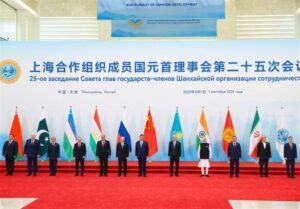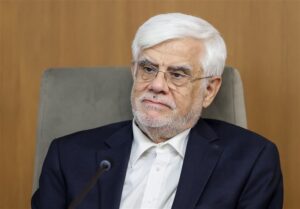Ali Mohammadpour, secretary of the Digital Publishers Association, a member of the Board of Directors of the Union of Content Production and Publishing, wrote in a note to the Tasnim News Agency:
While we are in the field of content production between numerous institutions and scattered regulations, Saudi Arabia has chosen another way in the year (2021): the formation of the “Digital Content Council”, the implementation of the “Ignite” program, the injecting of multi -budget budgets, the formulation of clear rules for content, and “construction of content”. That is clear: building a layer of content next to the network and infrastructure to both affect culture, diversify both the economy and to attract capital and elites.
From idea to implementation: What did Saudi Arabia do?
On September 29, 2021, the Cabinet of Saudi Ministers set up the “Digital Content Council” with a mission of implementing 36 initiatives and a ceiling of 4.2 billion riyals (more than $ 1 billion). From the beginning, four target markets were clear: video, audio and podcast, video games and digital advertising. The key point was the conversion of “arrangement” into the executive program under the Ignite umbrella; Including the formulation and implementation of the “Content Platform Service Provide Regulations” that clarified the path to licensing and activity requirements. At the same time, the Commission on Communications, Space and Technology has launched the idea of a secure port of digital content to gain a clearer legal hosting and passing content on Saudi soil and to make it more attractive to invest in data centers and content distribution networks.
Playgrounds of the platforms
The Saudi Communications, Space and Technology Commission has issued and enforced “Digital Content Services Provision Regulations”; The goal is to integrate regulations, transparency, neutrality and to enhance competition in the four markets of video, audio/podcast, game and digital advertising.
For all domestic and foreign providers, the “registration/license/activity announcement” route was activated on the official portal.
Implementation of the Regulations goes through the “Electronic Service Unit window”; The issuance and follow -up of licenses is carried out online and additional documents have been published on traffic neutrality and access to hosting content.
At the public transparency level, the text of the regulations, guides, and sector reports (including market status and licensing process) is publicly available.
The direct result for businesses was to reduce legal risk, increase prediction and reduce office friction; And of course the ease of entry of domestic and foreign actors and faster the capital and force to produce content
How does money turn the sheet back?
Saudi Arabia went to two familiar and efficient tools to live the “Content Production Economy”: cash repayment of production costs and investment participation funds. These two leverage are the common language of filmmakers and investors in the world; Just as it makes the number and risk easier and the decision is easy. Cash repayment up to 40 %; A number that makes the producer comfortable.
The national repayment program returns up to 40 % of eligible expenses to cinema and television productions in Saudi Arabia; From renting equipment and wages to stage and residence services. This means that if a project spends 10 units and meets the criteria, it will be in cash up to 4 units. Predictability in practice. This policy is also implemented in prominent locations such as al -Ala, and even increased privileges for the use of Saudi citizen forces.
Alongside this, the media city in the northwest of the country has announced with studios and ready -made decor that relying on a 40 % repayment program; That is, the financial mechanism and the production infrastructure are also handled so that the groups can get rid of “case bargaining” and move forward with a clear rule.
At the same time, the Cultural Development Fund has introduced widespread financing programs for 16 cultural infrastructures (including cinema and digital books and audiobooks, podcasts and music) to the content supply chain, not just “imaging” and the upstream and downstream parts. This means not only for the camera and decor, which was provided for the development of content, distribution, and peripheral businesses.
For a producer or platform, this combination is: Recovery money + tolerance. The cash repayment reduces the effective cost of production and removes partnerships, liquidity bottlenecks and the risk of liability. The result is the projects that, instead of budgeting the budget, are key and move forward with a clear financial plan.
The infrastructure of production; From “Nion” to “Al -Ala”
Saudi Arabia did not just spend money; The complete production cycle brought together: from standard scenes and vast locations to the training of force and solving office work. The result was that when a filmmaker arrives in Saudi Arabia, it faces a set that has both space, force, incentives, and enlightening administrative paths.
Media City
In Newm, large filming halls and backgrounds are available; The same thing that professional production wants: controlled silence, quick access, and accurate timing. The cash repayment program of production costs up to 40 % will make the costs foreseen and the short routes for registering the company and starting work will not waste time. In addition, skill courses are held in collaboration with reputable cinema schools and specialized gaming universities to offset the lack of skilled force before it becomes a node. Large media in the region, as a partner and customer, keep the wheel warm.
“Al -‘Ala”; A scene ready with unique scenery
Al -Ala has a natural advantage: the unrivaled rock and historical landscapes that make new frames for movie, serial and non -celebrity programs. Here is the repayment of up to 40 %; However, the local team remains with the production team from the same stage of licensing, customs and power supply. Simply put, the manufacturer focuses on the quality of the frame and the timing of the scene rather than the signatures and seals. The greater the share of the use of indigenous forces and the geographical display of the country, the easier access to the incentive ceiling.
A chain that stabilizes production
What Saudi Arabia has put together is not just equipment and niches. The network is formed from décor, light and sound companies to transportation, residence and insurance services; The skill courses, the light technician and the sound technician and the manager of the production; And administrative transparency minimizes lost time. For a producer, that is, less risk, more predictable costs, and safer scheduling.
This simple formula has not only worked in Saudi Arabia and has previously paved the way for international production in countries such as Greece, Malta, Morocco, Spain (especially the Canary Islands), Abu Dhabi, Ireland, Britain, the Czech Republic and Hungary; They have rescued the manufacturer from confusion and the names of their cities on the World Map of Content, with predictable tax repayments and tax credits, simple administrative processes, ready -made studios and locations, and talks with the class and the publication of transparent guides. Saudi Arabia is now the flagship of the region and the signal of stability and cooperation, relying on the same pattern and narrative of the event; A pattern that is also achieved with clever localization.
Saudi Media Regulatory Map
In 2023, the Cabinet approved a media supervisory body in Saudi Arabia, and its mission of “audio and image” expanded to the entire media field. A few months later, on December 19, 2023, the “new strategy and identity” was unveiled; They also explicitly targeted: bringing the media sector to 47 billion riyals to 2030 and attracting more capital and professional force.
Today, it is a “responsive unit authority” for licensing and monitoring media activities: from distribution and publication to content and advertising on traditional media and social media. Tasks include licensing, monitoring of servants, formulating technical standards, advertising, and technical coordination (eg, frequency and equipment). The legal backing of the work is the “2017 Visual Media Activities System” and the 2018 Executive Regulations; That is, a framework that clarifies the task of issuing and renewing the license, guaranteeing performances and protecting competition.
From “paper players” and to “work,” they have been active for licenses, reports of “media sector status and investment opportunities”, and annual performance reports with quantitative indicators; These are the tools that tell the investor and the producer what the rules of the game are and what he sees.
Alongside this “Media Map”, the Communications, Space and Technology Commission also announced “Content Platform Services Provide Regulations”; Regulations that brought the unit system to transparency, impartiality and non -discrimination, and specified the registration/license and notice requirements for internal and external platforms. The deadline was: October 8, 2024. At the same time, the commission has publicly consulted “Digital Content Secure Port” to host and transit the content under a clearer legal umbrella. These simple translations for business: an administrative shortcut, a known timetable, and less legal risk.
According to a newspaper: Saudi Arabia has brought “media regulation” from the level of slogan to executive operations-with a clear authority, a single gateway, adaptation calendar, and attachment documents-hearing both the investor voice, clarifying the manufacturer’s task, and for the citizen, the media space.
Iran and the opportunities that should not miss
Iran has a powerful “human and platform infrastructure” today. In video and serial, native platforms such as Filimo and Naqva with extensive archives and dedicated products have built the online watching market; As the main video subscription service, the apparatus hosts a large ecosystem of native channels and applications
In digital and audio book, niche, feedback and bookstore link to publishers and users, and have learned the legal release of e -books and audiobooks. In audio and podcasts, Shenuto, with thousands of channels and audio files, shows that the Persian -language audience is ready for audio content.
The print publishing base is still strong: thousands of publishers are active in the country and international estimates have recorded more than 100,000 books per year for Iran; A scale that is the natural backing of the transition to digital publishing.
There is no low capacity on the Persian web: Farsi covers about 1.1 % of the identified language websites; A number that, given the user and manufacturer’s population, enhances the possibility of growing native content market and export content.
Practical and simple offers to accelerate us
• Focusing instead of dispersal: A single window for permits and support throughout the chain (from idea to publication); Decisions with a clear and trackable calendar.
• Layer support: Specific packages for ideas, development, production, distribution and marketing – from micro -creators (podcasts/video/audio book, mobile gaming, etc.) to large series projects.
• Visible Transparency: A online dashboard of supported projects, sums, progress and outputs; Periodic reports of “Market situation” in books, images, music and games and more.
• Reduce production and publishing friction: Sample contracts, simple legal guide, short processes for registration/license/tax; Energy instead of paperwork.
• Predictive incentives: Cash repayment of eligible costs with an increasing score for the use of specialist force.
• Skills and Infrastructure in Cities: Short -term writing/technical courses with the participation of the university and class; Studios and multipurpose spaces in a few cultural poles.
• Flag Digital Content Event: Annual Persian Digital Content Festival simultaneously with Tehran International Book Fair; Attractive prizes and right -wing/adaptation markets.
• Content Exports on Farsi Web Borrower: A Reverse Translation and Translation Program to deliver Iranian books, serials and podcasts to regional and global markets.
These are not copying; The natural continuation of our previous successes is. With the same current capacity (active platforms, numerous publishers, a strong book market and a meaningful Persian share on the web), the “digital content economics” can be scored faster and more secure; A path that both protects our national pride and new opportunities for business and culture; And of course, the risk of being lagging behind is in our ambush. If we want to be left behind, we must move from scattered policies to politics; With the agile coordinator, clear rules, standard production incentives; A license to a fabric, transparency, and a flagship event that puts Tehran on a global content map. Saudi Arabia has moved the same route in the last four or five years, and now its works are.
End of message/
منبع:تسنیم







